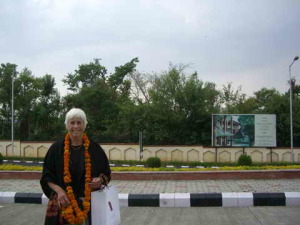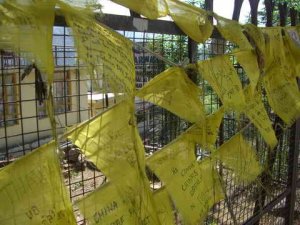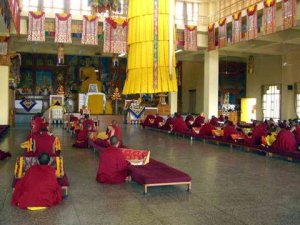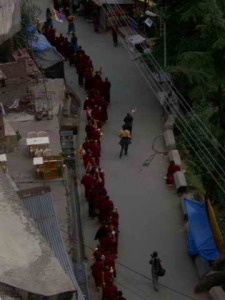When the Dalai Lama speaks, everyone listens.
In Dharmshala, India, where his exile government has existed for fifty years, hi s kingdom nestles in steep mountains covered in pines and oaks, monkeys, roaming cow, and white tourist vehicles. A horn beep accompanies you everywhere as you hold your breath on precarious turns. Simple buildings cling to the cliffs and a single narrow hairpin road leads from lower Dharmshala to upper Dharmshala better known as Mcloudgunge and it is at about 6000 feet high. Along the road are signs with such placards as “A thing of beauty is a joy forever,” “Birds choke on polythene, save their lives”, “Divinity is in nature”, “Nature is not a place to visit, it is our home,” “Protect our wildlife, they give us peace and love,” and my favorite: ” To see right and not to do is cowardice.”
s kingdom nestles in steep mountains covered in pines and oaks, monkeys, roaming cow, and white tourist vehicles. A horn beep accompanies you everywhere as you hold your breath on precarious turns. Simple buildings cling to the cliffs and a single narrow hairpin road leads from lower Dharmshala to upper Dharmshala better known as Mcloudgunge and it is at about 6000 feet high. Along the road are signs with such placards as “A thing of beauty is a joy forever,” “Birds choke on polythene, save their lives”, “Divinity is in nature”, “Nature is not a place to visit, it is our home,” “Protect our wildlife, they give us peace and love,” and my favorite: ” To see right and not to do is cowardice.”
In the deepest pine woods, we pass the Church of St. John in the Wilderness, the only structure that was left standing after a serious earthquake in the 19th century. Here is a monument to Lord Elgin, British Viceroy of India in the mid 1800s, and to James Bruce who was a popular British ambassador in Asia. I stop in for a prayer and a stroll through something familiar though unkempt.
There is a 24-7 television channel into which one can tune to watch/receive the abund ant blessings the Dalai Lama wishes for his people. His elaborate days of blessings packed with Tibetans, shaved headed monks and body guards, with a few Westerners observing, are full of color, musical notes, and chanting. So many gifts are brought to the Dalai Lama be it kata or yak butter candles or other personal donations from his people, that it takes hours to pass everything before him for his blessing. He is adored and worshiped. But these television records seem to be from better times. The D
ant blessings the Dalai Lama wishes for his people. His elaborate days of blessings packed with Tibetans, shaved headed monks and body guards, with a few Westerners observing, are full of color, musical notes, and chanting. So many gifts are brought to the Dalai Lama be it kata or yak butter candles or other personal donations from his people, that it takes hours to pass everything before him for his blessing. He is adored and worshiped. But these television records seem to be from better times. The D alai Lama, who is in his seventies, is such a superstar in both the political and celebrity world, that he has of late withdrawn from so many public appearances. His life has been threatened and the fight to save Tibet for the Tibetans has taken its toll. When he moves down the mountains, he is followed by ten to twenty vehicles of guards and police. His private Deccan plane, bullet proofed, was donated by Germany and rests at the tiny airport. He is only in residency about 12 per cent of the year. Otherwise, for tourist and officials, here is only one commercial flight a day from New Delhi.
alai Lama, who is in his seventies, is such a superstar in both the political and celebrity world, that he has of late withdrawn from so many public appearances. His life has been threatened and the fight to save Tibet for the Tibetans has taken its toll. When he moves down the mountains, he is followed by ten to twenty vehicles of guards and police. His private Deccan plane, bullet proofed, was donated by Germany and rests at the tiny airport. He is only in residency about 12 per cent of the year. Otherwise, for tourist and officials, here is only one commercial flight a day from New Delhi.
Our scheduled audience with the Dalai Lama, as well as that of an Indian minister ,who arrived in Dharmshala on the same plane as ours, were abruptly canceled. Although his web site said the Dalai Lama was to be in Dharmshala these two or three days, we were told that for safety sake, no one really knows where he is most of the time. He is leaving for Germany for talks about the China-Tibet situation. It was a great disappointment for me but then who am I but a minor American.
So we spent the day seeing exiled Tibetan holy life in Dharmshala. Over fifty years, the Tibetan monks have tried to re-create the ambiance of Lhasha, which was the headquarters of the Dalai Lama in Tibet, with his well known palace that spread across the mountains, his many temples and giant gold statues of Buddha, with Thankas (religious paintings), with wide holy seats or thrones for the Dalai Lama (on which he sits cross legged yoga style) which he uses for periodic teachings to his people, and with many many cells for monks in training at monasteries. At the monastery attached to the home of the Dalai Lama, the highest levels of study are pursued. Here Buddhist intellectuals are created. It takes 18 years to receive the master designation, and 21 years to become a Geshi Lama, as our friend from Pangboche, Nepal, had obtained. It is a major commitment for these young men to give their lives to such study and discipline. Some women shave their heads and become monks as well. (I was put off by the many Americans roaming the streets in Indian dress, dread locks hanging down their backs, and attempting to be Buddhists. None that I saw had attained the red and ochre costumes. But it looks like left-over hippie days. )
headquarters of the Dalai Lama in Tibet, with his well known palace that spread across the mountains, his many temples and giant gold statues of Buddha, with Thankas (religious paintings), with wide holy seats or thrones for the Dalai Lama (on which he sits cross legged yoga style) which he uses for periodic teachings to his people, and with many many cells for monks in training at monasteries. At the monastery attached to the home of the Dalai Lama, the highest levels of study are pursued. Here Buddhist intellectuals are created. It takes 18 years to receive the master designation, and 21 years to become a Geshi Lama, as our friend from Pangboche, Nepal, had obtained. It is a major commitment for these young men to give their lives to such study and discipline. Some women shave their heads and become monks as well. (I was put off by the many Americans roaming the streets in Indian dress, dread locks hanging down their backs, and attempting to be Buddhists. None that I saw had attained the red and ochre costumes. But it looks like left-over hippie days. )
Currentl y there are 1100 student monks, four to a room, with more facilities being built as fast as possible at the Karmapa monastery. The Karmapa lama is suspect by many Tibetans because he was appointed by Chinese authorities, and so they believe he is a spy for the Chinese government. But his monastery is in demand for its teaching.
y there are 1100 student monks, four to a room, with more facilities being built as fast as possible at the Karmapa monastery. The Karmapa lama is suspect by many Tibetans because he was appointed by Chinese authorities, and so they believe he is a spy for the Chinese government. But his monastery is in demand for its teaching.
Another shining stars in this rather transient but busy area is an oasis of waterfalls, gardens, and creative arts called Norbulingka or Jewel Park. In an effort to prevent Tibetan culture from disappearing, this place preserves Tibetan heritage. It treasures and promotes the artistic traditions of sculpture in wood, gold or silver, thangka painting and even fashion de signs, all of which can be purchased in a first class shop on the premises. There is a doll museum which displays the many styles of traditional dress of the Tibetans in scenes of daily life and dance. Prayer flags hang throughout this quiet place of stone steps and strange water runs. In high studios, thangka paintings are being produced with discipline. One artist had spent eight months on a holy thangka of the god of compassion who has a thousand arms and legs. He works with tiny paint brushes with one or two hairs to do his work.
signs, all of which can be purchased in a first class shop on the premises. There is a doll museum which displays the many styles of traditional dress of the Tibetans in scenes of daily life and dance. Prayer flags hang throughout this quiet place of stone steps and strange water runs. In high studios, thangka paintings are being produced with discipline. One artist had spent eight months on a holy thangka of the god of compassion who has a thousand arms and legs. He works with tiny paint brushes with one or two hairs to do his work.
Although I’m disappointed to have come so far and not been able to do the Mt. Kailash pilgrimage nor meet the Dalai Lama – and present him with a set of Episcopalian prayer beads – I have learned much about the pain of the Tibetan people. They are in constant protest to be set free from China’s domination. Last night there was a candlelight vigil passing under my windows led by ch anting monks. Tibetans who have settled in this Indian enclave can only have jobs making and merchandising their own traditional crafts. They cannot occupy other jobs that might rob Indians of their jobs. So the Tibetans set up stalls on the narrow streets to sell their blankets, beads, and cheap statuary.
anting monks. Tibetans who have settled in this Indian enclave can only have jobs making and merchandising their own traditional crafts. They cannot occupy other jobs that might rob Indians of their jobs. So the Tibetans set up stalls on the narrow streets to sell their blankets, beads, and cheap statuary.
There are three Tandric Buddhist sects in exile here, distinguishable by their holy hats during ceremony. The Dalai Lama is the supreme leader of the Gylupa sect, and wears the yellow hat. The oldest sect is Ningmapa, which is symbolized by a red hat; and the Kargu shows a black hat.
Posters at gates to temples blatantly show the bodies of Tibetans who have been tortured and killed by the Chinese in their homeland. Others protest the disappearance of the Pashan, a young holy child. I asked if Buddhists were cremated at death, and received the affirmative. But in Tibet, which is treeless, a giant dessert where the ground is frozen most of the year, there is no underground burial nor cremation since there is no wood. There exists sky burial. The body lies in state five to seven days. It is considered a vessel that has served its purpose.  It is taken to a special site after being shrouded and bloodletted. Then it is cut up into parts and fed to the birds, frantically waiting for their next meal.
It is taken to a special site after being shrouded and bloodletted. Then it is cut up into parts and fed to the birds, frantically waiting for their next meal.
To tap off the day, we were taken to a sweet shop – it’s really just a display case in the middle of the bustling street. Indian sweets are elaborate, the best being those called “barfee”. An odd name. The sweets are made by boiling milk, so they have a rather sour taste, and are only super sweet when soaked in syrup. They go well with the local valley tea, Kangra green tea.

You should check out http://www.kagyu.org to learn more about the Karmapa.